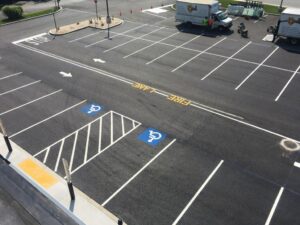 If you’ve ever parked in a well-organized lot, you’ve probably appreciated the clear lines guiding you to your spot. But have you ever wondered about the process behind those neat, orderly lines? What is parking lot striping?
If you’ve ever parked in a well-organized lot, you’ve probably appreciated the clear lines guiding you to your spot. But have you ever wondered about the process behind those neat, orderly lines? What is parking lot striping?
Parking lot striping is the process of painting lines and markings on parking lot surfaces to designate parking spaces, traffic lanes, and other important areas. It’s a crucial aspect of parking lot design and maintenance that ensures safe and efficient use of the space.
But there’s more to parking lot striping than just painting straight lines. Understanding the intricacies of this process can help property owners and managers make informed decisions about their parking facilities, potentially saving time and money while improving safety and compliance with local regulations.
Why Is Parking Lot Striping Important?
Parking lot striping serves several crucial purposes beyond simply creating an organized appearance. First and foremost, it enhances safety for both drivers and pedestrians. Clearly marked parking spaces, driving lanes, and pedestrian walkways help reduce the risk of accidents and confusion in busy parking areas.
Additionally, proper striping maximizes the use of available space, allowing for efficient parking arrangements that accommodate more vehicles. This is particularly important for businesses and public spaces where parking availability can directly impact customer satisfaction and revenue.
Furthermore, parking lot striping plays a vital role in compliance with local regulations and the Americans with Disabilities Act (ADA). Properly marked accessible parking spaces, complete with the required signage and access aisles, ensure that facilities meet legal requirements and provide equal access for all visitors.
How Often Should Parking Lot Striping Be Renewed?
The frequency of parking lot striping renewal depends on various factors, including the type of paint used, climate conditions, and the amount of traffic the lot receives. Generally, parking lot lines should be repainted every 18 to 24 months to maintain visibility and effectiveness.
However, high-traffic areas or lots exposed to harsh weather conditions may require more frequent restriping. For example, lots in regions with heavy snowfall and frequent plowing may need annual touch-ups to counteract the wear caused by snow removal equipment.
It’s important to regularly inspect your parking lot for signs of fading or wear. When lines become difficult to see, especially at night or in wet conditions, it’s time to consider restriping. Maintaining clear and visible lines not only enhances safety but also contributes to a professional appearance that can positively impact your property’s image.
What Are The Different Types Of Parking Lot Striping Paint?
When it comes to parking lot striping, the type of paint used can significantly impact the durability and visibility of the markings. There are three main types of paint commonly used for this purpose: water-based, oil-based, and thermoplastic.
Water-based paint is the most environmentally friendly option and is easy to apply. It dries quickly and is less expensive than other types. However, it’s also the least durable and may need to be reapplied more frequently, especially in high-traffic areas.
Oil-based paint offers better durability and weather resistance compared to water-based options. It adheres well to various surfaces and provides good visibility. However, it takes longer to dry and releases more volatile organic compounds (VOCs) during application.
Thermoplastic is the most durable option, capable of lasting up to 7 years with proper maintenance. It’s highly reflective, making it excellent for nighttime visibility. While it’s the most expensive option upfront, its longevity can make it cost-effective in the long run, especially for high-traffic areas. However, it requires specialized equipment for application and is less suitable for areas with frequent layout changes.
Can Parking Lot Striping Be Done In All Weather Conditions?
While it might seem like a straightforward task, parking lot striping is actually quite sensitive to weather conditions. The ideal conditions for striping include dry pavement, temperatures between 50°F and 80°F (10°C to 27°C), and low humidity. These conditions ensure proper paint adhesion and drying.
Striping in wet conditions is generally not recommended, as water can prevent the paint from properly bonding with the pavement surface. This can lead to poor visibility and premature wear. Similarly, extremely hot temperatures can cause the paint to dry too quickly, potentially resulting in uneven application or reduced durability.
Cold temperatures present their own challenges. If the temperature is too low, the paint may not cure properly, leading to cracking or peeling. Many professional striping companies use specialized paints designed for colder temperatures when working in cooler climates or during winter months.
It’s also important to consider the forecast following the striping process. Ideally, there should be a window of at least 24 hours of dry weather after application to allow the paint to fully cure. This is why many parking lot owners choose to schedule striping during the drier months of the year when possible.
What Are Some Common Mistakes To Avoid In Parking Lot Striping?
While parking lot striping may seem straightforward, there are several common mistakes that can lead to poor results, safety issues, or non-compliance with regulations. Being aware of these can help property owners and managers ensure a successful striping project.
One frequent error is improper spacing between parking stalls. Standard parking spaces typically measure 9 feet wide by 18 feet long, but these dimensions can vary based on local regulations. Incorrect spacing can lead to inefficient use of space or difficulties for drivers when parking.
Another mistake is neglecting to properly clean and prepare the surface before striping. Dirt, oil, or debris on the pavement can prevent paint from adhering correctly, leading to premature wear and fading. Proper preparation, including sweeping and sometimes power washing, is crucial for long-lasting results.
Failing to comply with ADA regulations is a serious oversight. This includes not providing the correct number of accessible spaces, improper dimensions for these spaces, or missing required signage. Non-compliance can result in legal issues and fines.
Lastly, using the wrong type of paint for the job is a common mistake. As discussed earlier, different paints have different properties and are suited for various conditions. Choosing the wrong paint can lead to poor visibility, rapid fading, or the need for frequent reapplication.
By avoiding these common pitfalls and working with experienced professionals, property owners can ensure their parking lot striping is efficient, compliant, and long-lasting.
Taking Action: Your Next Steps
Now that you understand the importance and intricacies of parking lot striping, it’s time to take a critical look at your own parking facility. Schedule a thorough inspection of your parking lot’s current striping condition, paying close attention to fading lines, worn markings, and any areas that might not comply with ADA regulations. Based on this assessment, you can determine if it’s time to contact a professional parking lot striping service to ensure your facility remains safe, efficient, and compliant.






